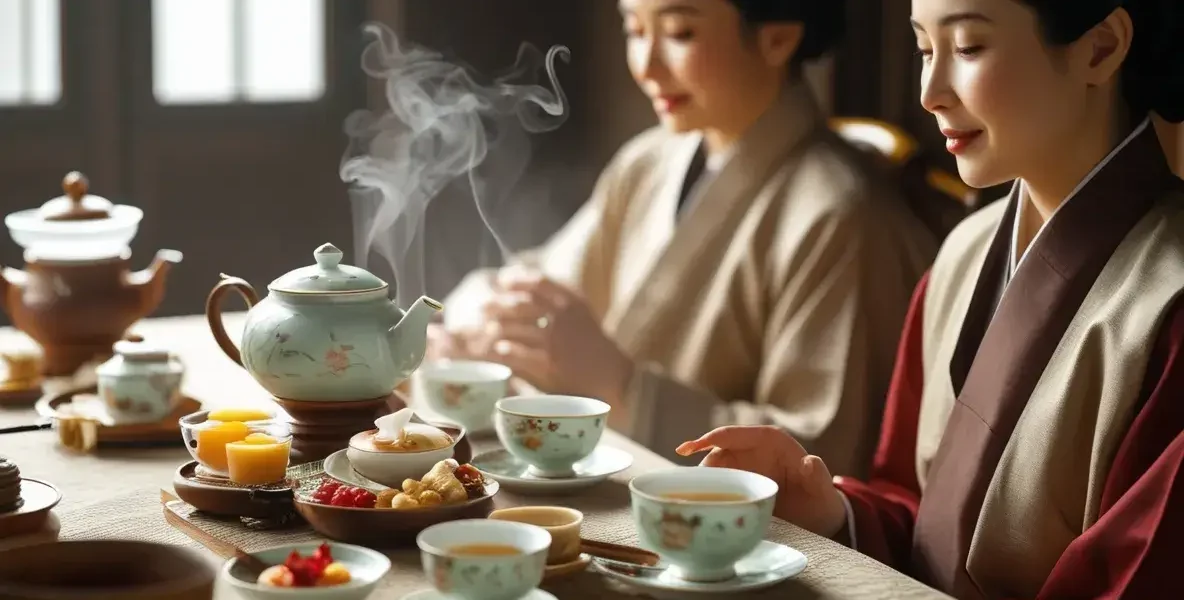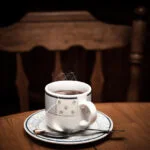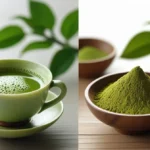Table of Contents
Did you know that tea was accidentally discovered in China around 2737 BC when Emperor Shen Nong experienced its invigorating properties for the first time? Our tea culture of the world review begins with this fascinating origin.
Interestingly, it takes about 2,000 tiny tea leaves to make just one pound of finished tea, yet this labor-intensive beverage has captivated cultures across the globe. From the mindfulness-focused Japanese tea ceremony with its subtle matcha flavors to the hospitable Moroccan tradition where serving mint tea is an essential component of welcoming guests, tea ceremonies reflect diverse rituals and philosophies.
As we explore tea traditions around the world, we’ll journey through China’s breathtaking array of teas like crisp Longjing and smoky Lapsang Souchong, discover how the Russian samovar keeps water hot for hours of cozy drinking, and learn why it’s considered polite to drink at least three cups during the Tibetan Butter Tea Ceremony.
Whether you’re fascinated by the Zen Buddhist philosophy behind Japanese tea rituals or curious about the spice-infused masala chai that’s become a staple across India, this guide will help you understand and appreciate tea traditions that have connected people for centuries. Let’s steep ourselves in the rich cultural heritage of tea rituals around the world!
Understanding Tea Culture Around the World
Tea ceremonies are intricate dances of tradition that go far beyond simply steeping leaves in hot water. Throughout history, these rituals have connected people across continents and revealed the soul of cultures worldwide. Let’s explore the fascinating world of tea traditions that continue to bring people together today.
What is a tea ceremony?
A tea ceremony refers to the ritualized preparation and presentation of tea, often conducted with specific protocols that vary widely across cultures. While Western observers might perceive these practices as merely ceremonial, many cultures have deeper terms for their traditions. In Japan, for example, the practice is called “Sadō” or “Chadō,” literally meaning “the Way of Tea,” emphasizing the Taoist philosophy behind the practice rather than just the presentation.
At its core, a tea ceremony transforms an everyday beverage into an art form through codified procedures. The Japanese tea ceremony involves the preparation of powdered green tea (matcha) using a procedure called “temae,” while Chinese Gongfu focuses on technique and quality, incorporating multiple infusions of the same leaves to create a rich sensory experience.
Tea ceremonies typically include several key elements:
- A designated space or environment (like the Japanese chashitsu or tea room)
- Specialized equipment handled with reverence
- Precise movements and gestures
- Specific etiquette for both hosts and guests
- Attention to seasonality and esthetics
Unlike casual tea drinking, these ceremonies offer participants a temporary withdrawal from everyday life, creating opportunities for mindfulness, connection, and appreciation of beauty.
Why tea rituals matter in different cultures
Tea rituals serve as cultural mirrors, reflecting the values and philosophies of the societies that practice them. In Japan, the principles of harmony (wa), respect (kei), purity (sei), and tranquility (jaku) established by tea master Sen no Rikyū in the 16th century remain central to the tea ceremony today. Additionally, the ritual embodies influences from both Zen Buddhism and Shinto, combining spiritual elements with esthetic appreciation.
Across cultures, tea ceremonies fulfill various social functions. In Morocco, tea represents hospitality and friendship, with mint tea offered to guests as a warm welcome. Meanwhile, in Britain, afternoon tea evolved into a refined social occasion that provided opportunities for conversation and connection.
Furthermore, tea ceremonies create spaces for meaningful human interaction. The intimate setting of a Japanese tea room accommodates only four or five people, fostering focused conversation and connection. Similarly, in Korea, the Darye ceremony emphasizes “the ease and naturalness of enjoying tea” in a formal yet comfortable setting.
How tea became a global tradition
Tea’s journey from a local Chinese beverage to a global phenomenon spans centuries of cultural exchange. Initially introduced to Japan in the 6th century by Buddhist monks visiting China, tea was primarily consumed by religious classes. Throughout East Asia, tea gradually transitioned from a medicinal drink to a spiritual practice and eventually a social custom.
The spread of tea to the West followed various trade routes. By 1657, tea was being sold in London coffee houses, and by the end of the 17th century, it had become an important source of tax revenue for the British Empire. This economic significance eventually contributed to major historical events, including the First Opium War.
As tea traveled, it adapted to local tastes and customs. In Tibet, tea is brewed with salt and butter, while in India, chai incorporates milk and aromatic spices like cardamom, cinnamon, ginger, and cloves. These variations reflect not only regional preferences but also available resources and cultural contexts.
Today, the global nature of tea culture allows people to experience diverse traditions without leaving their homes. Urban tea houses offer fusion styles, tea tastings provide educational opportunities, and modern adaptations like bubble tea create new traditions while honoring ancient roots.
👉 Experience the Premium Moroccan Mint Tea Flavor Now 👈
Famous Tea Traditions Around the World
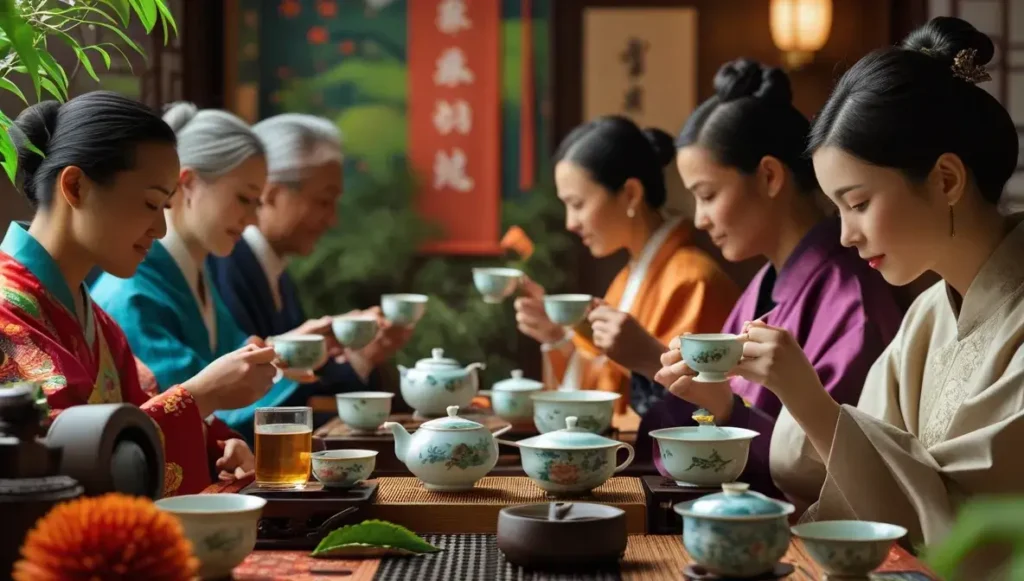
Across continents and through centuries, various cultures have developed unique approaches to tea preparation and consumption. These rituals reflect deep cultural values and offer fascinating insights into different societies. Let’s explore five remarkable tea traditions that continue to captivate tea enthusiasts worldwide.
Japanese Chanoyu: Harmony and mindfulness
The Japanese tea ceremony, known as Chanoyu or Chado (“the way of tea”), transforms tea preparation into a spiritual practice centered around four core principles:
- Harmony (wa) – creating balance with nature and others
- Respect (kei) – showing deep appreciation for people and objects
- Purity (sei) – maintaining physical and spiritual cleanliness
- Tranquility (jaku) – cultivating inner peace and mindfulness
In this ceremony, the finest matcha (powdered green tea) is prepared with meticulous care in a tranquil setting designed to foster self-reflection and meditation. Each movement during preparation is intentional and follows age-old traditions, creating a profound experience that goes beyond merely drinking tea. The practice embodies Zen Buddhist principles and Wabi-Sabi esthetics, celebrating beauty in simplicity and imperfection.
Chinese Gongfu Cha: Precision and aroma
China, home to the world’s oldest tea culture dating back over 2000 years, gave birth to Gongfu Cha, a practice emphasizing skilled preparation. Unlike Western brewing methods, Gongfu Cha utilizes smaller teapots (holding less than half a liter) and features multiple infusions of the same leaves to reveal their full spectrum of flavors. Oolong and Pu-erh teas are particularly favored as they can be re-steeped numerous times.
Central to this tradition is the Gaiwan, a vessel consisting of a bowl, lid, and saucer that merges functionality with cultural significance. Through this precise brewing method, participants can appreciate subtle changes in the tea’s flavor profile across multiple infusions, often pausing to admire the color and aroma together.
Indian Chai: Spice and social connection
In India, chai permeates daily life without formal rituals. This ubiquitous beverage appears everywhere from private kitchens to bustling street stalls managed by Chaiwalas. What distinguishes Indian chai is its distinctive blend of spices and milk, particularly in Masala Chai which combines black tea with cardamom, cinnamon, ginger, fennel seeds, pepper, and cloves.
Chai in India represents hospitality and warmth, serving as a social catalyst that brings people together. The preparation and consumption of chai are deeply intertwined with everyday interactions, creating opportunities for conversation and connection across all social boundaries.
British Afternoon Tea: Elegance and etiquette
Afternoon tea, a quintessentially British tradition traced back to Duchess Anna of Bedford, celebrates refinement and sociability. Once exclusive to the upper echelons of society, this practice now extends throughout the nation. The typical service features strong black tea (often with milk and sugar) accompanied by scones, mini sandwiches, and small pastries.
The joy of this tradition lies not merely in the culinary delights but in the shared experience. Specific etiquette governs the experience—from how to stir tea without clinking the spoon against the cup to the proper way to eat scones (broken by hand, never cut with a knife).
Moroccan Mint Tea: Hospitality in a glass
In Morocco, mint tea symbolizes hospitality and welcome. This cherished beverage blends Chinese green tea (typically Gunpowder) with fresh mint and generous amounts of sugar. Throughout the Maghreb region, tea is an all-day affair present at gatherings from casual meetups to significant celebrations.
The preparation involves an elaborate pouring technique where the host lifts the teapot at least 40 centimeters above small, colorful glasses, creating a distinctive foam layer—considered a mark of quality tea. Refusing offered tea is considered impolite, as the beverage represents the host’s hospitality. Following tradition, guests typically drink three glasses, each with subtly different flavors described in a famous proverb: “The first glass is as gentle as life, the second is as strong as love, the third is as bitter as death.”
Tools and Etiquette in Traditional Tea Ceremonies
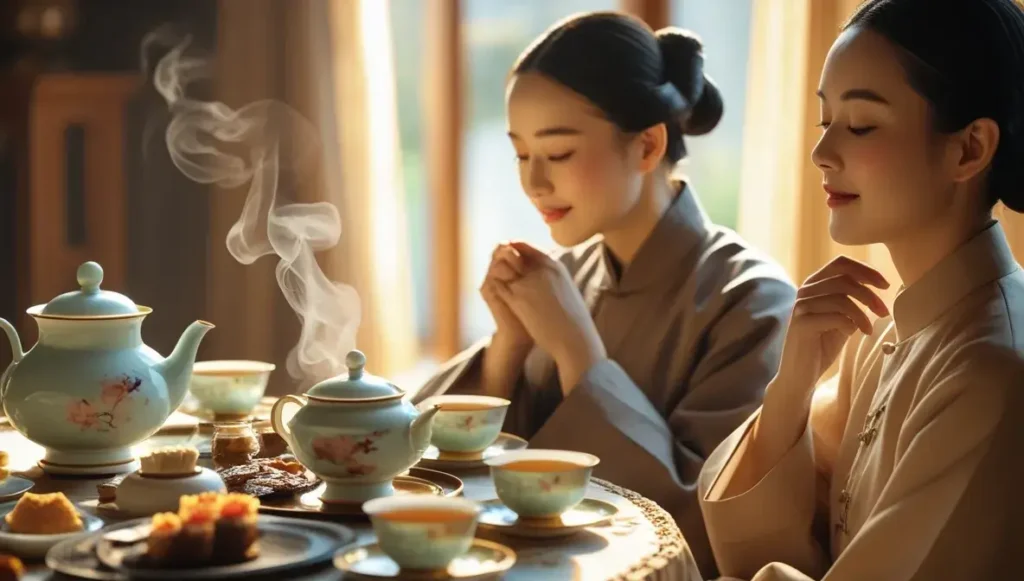
The beauty of tea ceremonies lies not just in the beverage itself, but in the specialized tools and respectful behaviors that transform the act of drinking into a meaningful ritual. Across cultures, specific implements and customs create a framework for appreciating tea’s subtleties and connecting with others through shared experiences.
Essential teaware used in ceremonies
Traditional tea ceremonies require specialized equipment that varies by region and style. In Japan, the essential dogu (tools) include the chawan (tea bowl), chasen (bamboo whisk), chashaku (tea scoop), chakin (hemp cloth), and natsume (tea caddy). Each item serves both functional and esthetic purposes in the ceremony. The chasen, notably carved from a single piece of bamboo, is considered irreplaceable as there are no suitable alternatives for whisking matcha.
Chinese Gongfu Cha emphasizes precision through vessels like the gaiwan (lidded bowl) and small teapots, typically holding less than half a liter. In contrast, British tea service features porcelain cups with saucers, teapots, and specialized plates for accompanying foods.
Common etiquette across tea cultures
Despite cultural differences, certain etiquette principles appear consistently in tea traditions worldwide. Respect for the host is paramount, shown through gestures like receiving tea with both hands in Japan and Tibet. In China, guests express gratitude through “finger kowtow” – tapping two fingers on the table as silent thanks to the server.
Generally, moderation governs behavior during tea ceremonies. Under no circumstances should guests slurp tea loudly or look anywhere but into the cup while sipping. Furthermore, stirring in circular motions is inappropriate in British traditions; instead, the proper technique involves gently folding the liquid back and forth.
How to serve and receive tea respectfully
Serving tea properly demonstrates consideration and respect. When pouring tea, both hands must be used – one holding the vessel and the other supporting it underneath. Teacups with designs should be positioned with the pattern facing the guest. Moreover, in many Asian traditions, the cup should never be filled completely, as this allows guests to hold it comfortably without burning themselves.
As a guest, proper reception includes accepting the cup with both hands, taking small sips rather than gulps, and in some cultures like Tibet, never completely emptying your cup, as hosts will continually refill it. Through these seemingly small gestures, tea ceremonies create spaces for meaningful connection across cultural boundaries.
👉 Indulge in the Finest British Afternoon Tea Collection Today 👈
Modern Takes on Ancient Tea Rituals
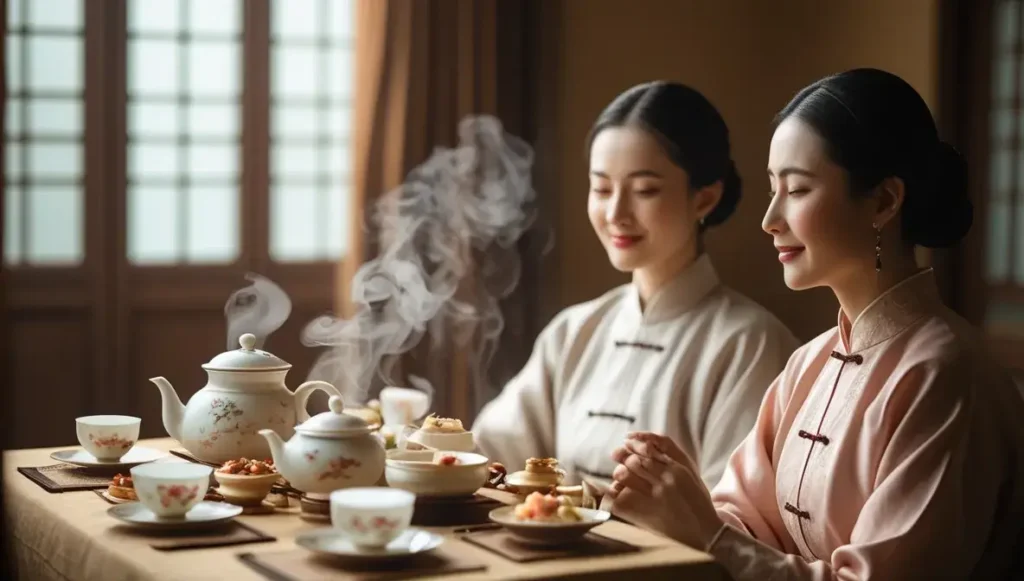
Traditional tea ceremonies have found new life in the 21st century, evolving beyond ancient practices to meet contemporary preferences without losing their cultural essence. Today’s tea enthusiasts enjoy both traditional rituals and innovative interpretations that honor heritage while embracing modern sensibilities.
Urban tea houses and fusion styles
Modern urban tea houses have reimagined traditional tea experiences for today’s consumers. These establishments blend ancient tea wisdom with contemporary esthetics, creating spaces where good food, quality drinks, and warm hospitality converge. Urban Tea House, for instance, offers a vibrant culinary oasis that celebrates Korean and Japanese flavors alongside premium teas. These venues serve as community hubs where people can connect outside of business settings, fostering relationships through shared tea experiences.
The Tea Collective exemplifies this evolution, combining traditional elements with contemporary flair through innovative offerings like matcha-infused lattes and herbal tea cocktails. Simultaneously, many establishments maintain deep reverence for tea’s heritage, emphasizing sustainability and ethical sourcing practices.
Tea tastings and workshops
Tea education has become increasingly popular, with tastings and workshops transforming casual drinkers into engaged enthusiasts. These experiences blend sensory learning with cultural storytelling, creating opportunities to deepen tea appreciation through hands-on engagement. Corporate virtual tastings, which gained momentum during the pandemic, now offer team-building activities across the United States.
Customizable experiences range from in-studio guided tastings to office-based events that provide relaxed yet educational environments. Throughout these sessions, participants typically taste 3-4 premium tea varieties while learning about production methods, brewing techniques, and cultural significance.
Bubble tea and other modern adaptations
Perhaps no modern tea innovation has captured global attention quite like bubble tea. Originating in Taiwan, this beverage has transcended its role to become a cultural touchstone, especially within Asian-American communities. The global bubble tea market, valued at $2.02 billion in 2022, is projected to reach $4.30 billion by 2027, growing at an impressive annual rate of 7.5%.
Several factors drive bubble tea’s remarkable popularity:
- Strong appeal among younger demographics, with 80% of Gen Z and Millennials enjoying it regularly
- Customizability through various flavors, toppings, and sugar levels
- Social media appeal through visually striking presentations
Bubble tea shops have consequently evolved into social hubs, with research showing 60% of enthusiasts visit primarily for the social experience rather than just the beverage itself.
How to Start Your Own Tea Ritual at Home
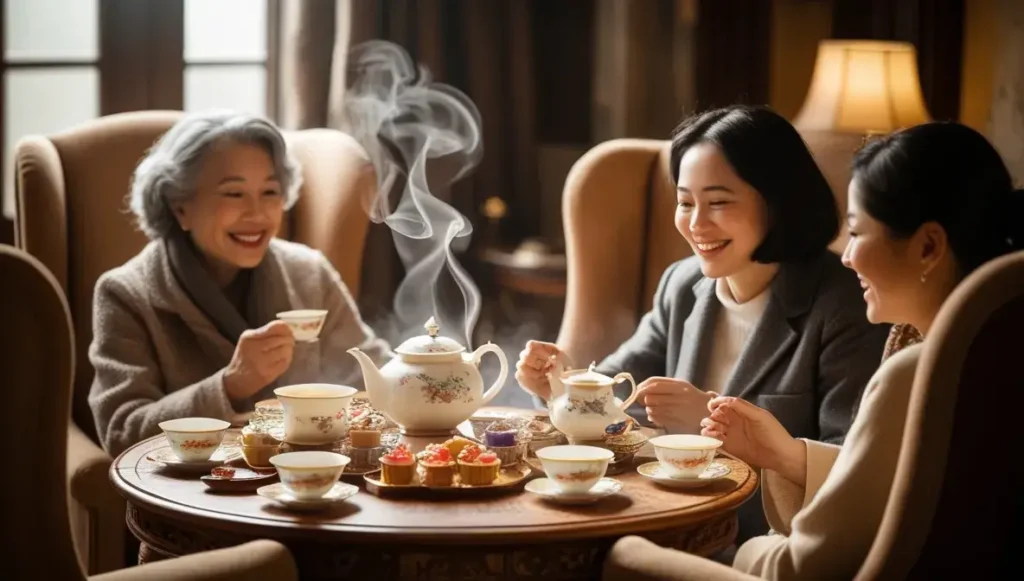
Bringing ancient tea traditions into your home begins with intention and simplicity. Through a personal tea ritual, you can create moments of tranquility that reconnect you with yourself and the rich heritage of tea culture.
Choosing your tea and tools
Quality matters when selecting tea for your ritual. As many tea masters suggest, “There is no good tea without good water,” so consider using filtered water rather than tap water with impurities. Invest in essential tools that match your preferred style:
- For matcha lovers: chawan (tea bowl), chasen (bamboo whisk), and chashaku (bamboo scoop)
- For gongfu style: small teapot or gaiwan, fairness pitcher, and small cups
- For Western brewing: teapot, infuser, and cup or mug that feels comfortable in your hands
Creating a calming tea space
Designate a specific area for your tea practice—perhaps a windowsill catching morning light, a quiet corner with a view, or simply a comfortable chair. Keep this space clean, uncluttered, and free from distractions. Add elements that engage your senses: soft lighting, calming scents from candles or incense, and perhaps a small vase with a single flower. Above all, this space should feel like a personal sanctuary where time slows down.
Making tea a daily mindful habit
Schedule your tea ritual regularly—whether daily or weekly—and prepare your tea tray in advance. During your practice, focus on each step: hearing the water boil, watching the color change as water meets leaves, feeling the warmth of the cup in your hands. Take small sips, allowing the taste to linger. This deliberate approach transforms a simple beverage into a profound experience of presence and appreciation.
👉 Try Our Top-Rated Moroccan Mint Tea Collection Now 👈
Recap of Our Tea Culture of the World Review Journey

Tea culture represents far more than just a beverage – it embodies centuries of tradition, mindfulness, and human connection. Throughout this journey across global tea traditions, we’ve discovered how these ancient rituals continue to bring people together while reflecting unique cultural values.
From the meditative Japanese Chanoyu to the precise Chinese Gongfu Cha, each tradition offers its own perspective on what makes tea special. Undoubtedly, these ceremonies teach us to slow down and appreciate small moments amidst our fast-paced lives. The hospitality shown through Moroccan mint tea or the refinement of British afternoon tea reminds us that sharing tea creates bonds that transcend language and borders.
Most importantly, tea rituals provide something our modern world desperately needs – opportunities for genuine human connection. Whether you prefer the spice-infused warmth of Indian chai or the innovative bubble tea that has captivated younger generations, tea offers a bridge between ancient wisdom and contemporary life.
You don’t need elaborate equipment or extensive training to begin your own meaningful tea practice. Actually, starting with quality tea, basic tools, and a dedicated space allows anyone to transform a daily habit into a mindful ritual. This simple act connects you with a tradition practiced by countless people across cultures and throughout history.
The next time you prepare a cup of tea, try approaching it with intention and awareness. Notice the aroma, feel the warmth, and savor each sip. Through this thoughtful practice, we honor tea’s rich cultural heritage while creating our own personal traditions that bring peace and presence to everyday life.
Key Takeaways
Master the art of tea culture by understanding that these ancient rituals offer much more than just drinking—they provide pathways to mindfulness, cultural connection, and meaningful human interaction across diverse traditions.
• Tea ceremonies transform daily habits into mindful practices – From Japanese Chanoyu’s harmony principles to Chinese Gongfu Cha’s precision, each tradition teaches presence and appreciation.
• Respect and proper etiquette create meaningful connections – Use both hands when serving/receiving tea, take small sips, and follow cultural customs to honor the tradition.
• Start your home ritual with quality basics – Choose good tea and filtered water, designate a calm space, and focus on each step to create your personal sanctuary.
• Modern adaptations keep ancient wisdom alive – Urban tea houses, bubble tea culture, and fusion styles prove that traditional practices can evolve while maintaining their cultural essence.
• Tea serves as a universal bridge across cultures – Whether it’s Moroccan hospitality, British elegance, or Indian social connection, tea rituals create bonds that transcend language and borders.
The beauty of tea culture lies in its accessibility—you don’t need elaborate equipment or extensive training to begin experiencing the mindfulness and connection that have captivated people for over 2,000 years.
👉 Taste the Signature Premium British Afternoon Tea Blend Today 👈
FAQs
Q1. What are some of the most famous tea ceremonies around the world? Some of the most renowned tea ceremonies include Japanese Chanoyu, which focuses on harmony and mindfulness; Chinese Gongfu Cha, known for its precision and emphasis on aroma; Indian Chai, celebrated for its spices and social connections; British Afternoon Tea, characterized by elegance and etiquette; and Moroccan Mint Tea, symbolizing hospitality.
Q2. How can I start my own tea ritual at home? To start your own tea ritual, choose quality tea and appropriate tools for your preferred style. Create a calm, dedicated space for your practice, free from distractions. Make it a regular habit, focusing on each step of the process mindfully, from hearing the water boil to savoring the taste of each sip.
Q3. What is the cultural significance of tea ceremonies? Tea ceremonies hold deep cultural significance, often embodying values like respect, harmony, and mindfulness. They serve as a means of social connection, hospitality, and even spiritual practice in many cultures. These rituals transform the simple act of drinking tea into an art form that reflects cultural philosophies and traditions.
Q4. How has tea culture evolved in modern times? Modern tea culture has adapted to contemporary tastes while maintaining its traditional roots. Urban tea houses offer fusion styles, combining ancient wisdom with modern esthetics. Tea tastings and workshops have become popular educational experiences. Innovations like bubble tea have created new global phenomena, appealing particularly to younger generations.
Q5. What are some common etiquette rules in tea ceremonies? While specific etiquette varies across cultures, some common rules include: using both hands when serving or receiving tea, taking small sips rather than gulps, avoiding loud slurping, and showing respect to the host. In many Asian traditions, it’s also customary not to fill the cup completely, allowing guests to hold it comfortably without burning themselves.
